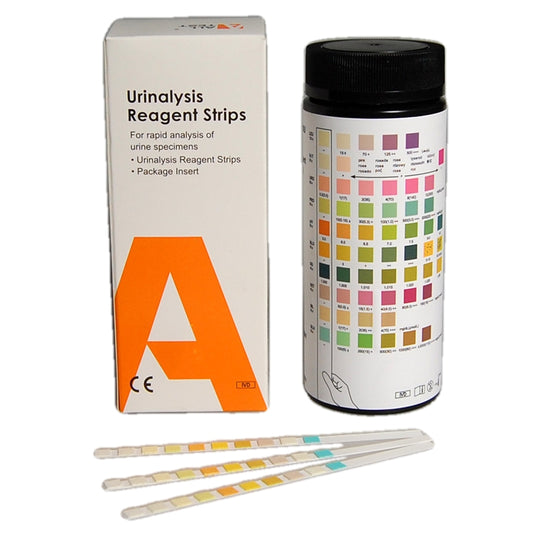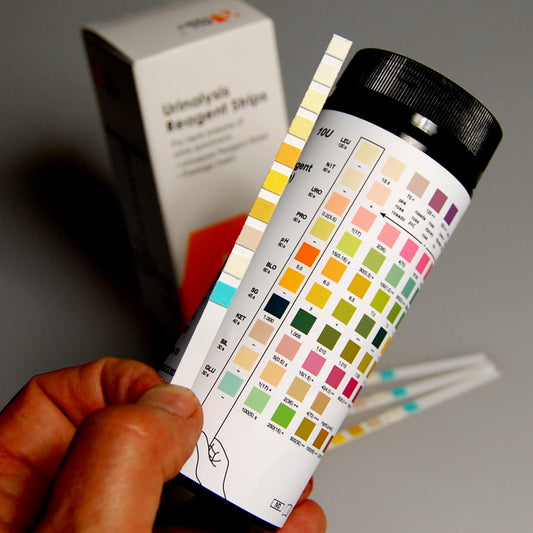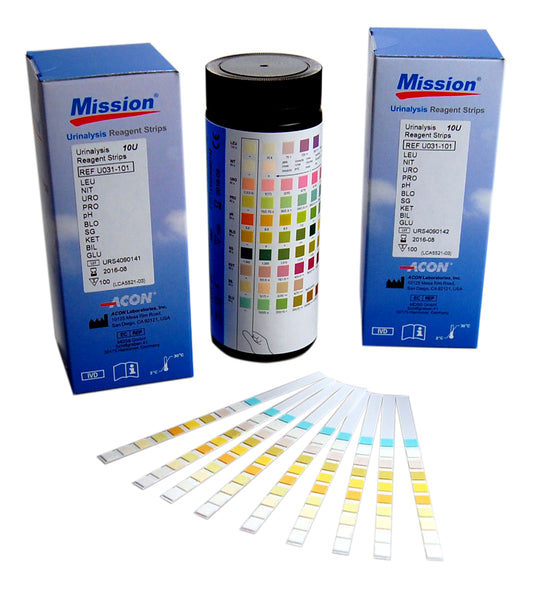Collection: Urine Ketone Test Strips
-
ALLTEST 10 Parameter URS10 Urine Test Strips Pack of 100 test strips
12 reviewsRegular price £7.75 GBPRegular priceUnit price / per -
VECHEK 11 Parameter Urine Test Strips For Vets And Pets URS Pot Of 25 Urine Strips
2 reviewsRegular price £4.95 GBPRegular priceUnit price / per£5.95 GBPSale price £4.95 GBPSale -
MISSION 10 Parameter Urine Test Strips Pack of 100 URS10U
2 reviewsRegular price £8.99 GBPRegular priceUnit price / per
Ketone test strips for urine
Urine ketone strips are used to measure the level of ketones in your urine. Ketones are produced when your body breaks down fat for energy, which can happen when you're following a low-carb diet (such as the ketogenic diet), fasting, or if you have certain medical conditions like diabetes. Monitoring ketone levels can be important for people with diabetes to avoid a dangerous condition called diabetic ketoacidosis (DKA).
Blood ketone test strips for sale here
Key features of the urine ketone strips
- The ketone test strips that we stock are incorporated into a URS 10
- Allow urine ketone levels to be measured in less than 2 minutes
- Urine ketone strips normal range negative to 16mmol/L
- Each pot contains 100 urine test strips
- The test strips are available from UK stock.
- Bulk and wholesale packs of ketone test strips are also available to buy online
- Contact our trade team for larger volumes of ketone tests

Here's how to use urine ketone strips:
- Gather your supplies: You'll need a clean, dry container for collecting a urine sample, the ketone strips, and a timer (optional).
- Wash your hands: Always start with clean hands to prevent contamination of the urine sample.
- Collect a urine sample: For the most accurate results, it's best to collect the first-morning urine, as it tends to be more concentrated, and often ketone levels are highest first thing in the morning as you have fasted overnight. You can also collect a sample at other times of the day, but make sure you haven't recently consumed large amounts of water, as this can dilute the ketone concentration in your urine. Use a clean, dry container to catch the urine. You only need a small amount, typically about half an inch in the container.
- Dip the strip: Remove one ketone strip from its container and be sure to close the container tightly to keep the remaining strips dry. Dip the strip into the urine sample for a few seconds (usually around 5-10 seconds). Follow the specific instructions provided with the ketone strips, as the time may vary by brand.
- Remove and shake off excess urine: Gently shake the strip to remove any excess urine.
- Wait for results: The strip will change colour to indicate the level of ketones in your urine. Different brands of strips may have varying colour scales, so consult the instructions provided with the strips to interpret the results accurately.
- Compare the strip to the colour chart: Most ketone strips come with a colour chart that corresponds to different levels of ketones in your urine. Match the colour on the strip to the closest colour on the chart to determine your ketone level.
- Record your results: Keep a record of your ketone levels over time, especially if you're monitoring for a specific purpose, like a low-carb diet or diabetes management.
- Dispose of the strip properly: Most ketone strips are disposable and should be discarded in accordance with local regulations for medical waste.
Understanding Ketone Test Strip Results
Ketone test strips are used to measure the presence of ketones in urine. These are commonly used by people following a ketogenic diet, those with diabetes, or individuals monitoring their fat metabolism.
How Ketone Test Strips Work
- The strips contain a reagent pad that changes colour in response to ketones in urine.
- After dipping the strip into a urine sample, the colour is compared to a chart on the packaging to determine the ketone level.
Ketone Levels & Their Meanings
| Ketone Level | Possible Indication |
|---|---|
| Negative (0 mmol/L) | No significant ketones detected. |
| Trace (0.5 - 1.5 mmol/L) | Mild ketosis – could be due to fasting, early keto diet adaptation, or mild dehydration. |
| Moderate (1.5 - 3.0 mmol/L) | Nutritional ketosis – common in a well-managed ketogenic diet. |
| High (3.0 - 5.0 mmol/L) | Deeper ketosis – often seen in prolonged fasting or strict keto dieting. |
| Very High (above 5.0 mmol/L) | Risk of ketoacidosis (if diabetic) – seek medical advice if feeling unwell. |
Key considerations when using ketone strips
- Ketone strips measure acetoacetate, one type of ketone, but not beta-hydroxybutyrate (BHB), which is measured in blood ketone tests.
- Hydration levels and urine concentration can affect results.
- In diabetics, high ketones with high blood sugar can indicate diabetic ketoacidosis (DKA), a serious condition requiring immediate urgent medical attention.
It's important to note that urine ketone strips provide information about ketones that have been excreted in your urine, which may not always reflect your current blood ketone levels. For more precise monitoring, some people with diabetes may use blood ketone meter and blood ketone strips. If you have any medical conditions or concerns related to ketones, consult with a healthcare professional for guidance on how to use ketone strips effectively and interpret the results in the context of your specific situation.
Frequently asked questions anout ketone test strips
Whether you're following a ketogenic diet, practising intermittent fasting, or monitoring your fat metabolism, ketone test strips are a quick and easy way to check your ketone levels. This FAQ section covers everything you need to know about using ketone test strips effectively, understanding your results, and troubleshooting common issues.
If you're new to testing or want to get the most accurate readings, read on for expert tips and answers to the most frequently asked questions!
Collapsible content
What are ketone test strips used for?
Ketone test strips are used to measure ketone levels in urine. They help individuals on a ketogenic diet, those monitoring fat metabolism, and people with diabetes who need to check for ketoacidosis.
Can dehydration affect ketone test strip results?
Yes. Dehydration can make urine more concentrated, leading to false high readings. Drinking enough fluids can help ensure more accurate results.
Are urine ketone tests accurate?
Urine ketone tests are a good general indicator, but they may not be as precise as blood ketone meters, which measure beta-hydroxybutyrate (BHB), a more reliable marker of ketosis. Urine ketone test are good if you prefer not to do fingerprick testing but they are not as accurate as blood ketone test strips used with a meter.
Why are my ketone levels low even though I follow a ketogenic diet?
- Your body may be efficiently using ketones for energy, leaving fewer to be excreted in urine.
- You may be consuming too much protein, which can be converted into glucose and reduce ketosis.
- Your body has adapted to ketosis over time, meaning urine ketones decrease while blood ketones (BHB) may still be present.
How often should I test for ketones?
- If following a keto diet, testing once a day or a few times per week can help track ketosis.
- If managing diabetes, your doctor may advise testing if blood sugar levels are high or if you feel unwell.
Do ketone test strips expire?
Yes. Most urine test strips have a shelf life of 3–6 months once opened. Store them in a cool, dry place and keep the lid tightly sealed to prevent exposure to moisture.
Can ketone strips diagnose diabetic ketoacidosis (DKA)?
Ketone strips can indicate high ketones, but they do not diagnose DKA. If you have high ketones, high blood sugar, nausea, vomiting, or confusion, seek immediate medical attention.
Can I use ketone test strips while fasting?
Yes! Many people use ketone test strips to track ketone levels during intermittent fasting or extended fasts. Levels typically increase after several hours without food.
Can I be in ketosis without showing ketones on the strip?
Yes! Some people become on low carbohydrate diets become so efficient at using ketones that they don’t spill excess into urine. Blood ketone testing may be a better indicator in this case.
Will ketone test strips show results if I’m doing intermittent fasting?
Yes! Fasting naturally increases ketone production. If you are fasting correctly, you should see ketone levels rise after several hours without food.





